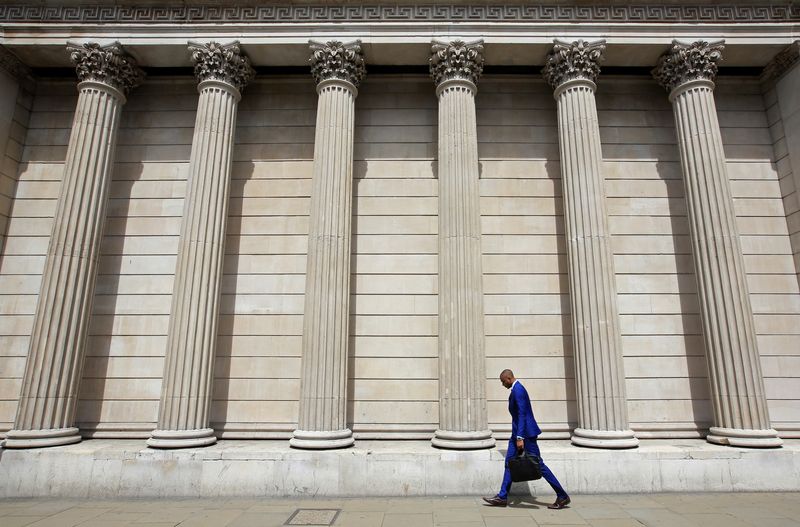
© Reuters. A man walks past the Bank of England in the City of London, Britain June 28, 2016. REUTERS/Paul Hackett/File Photo
LONDON (Reuters) – Britain’s economy is “moving in the right direction” for the Bank of England to start cutting interest rates, Governor Andrew Bailey said as two of his colleagues dropped their vote for a rate hike.
The BoE’s interest rate-setters voted 8-1 to keep borrowing costs at their 16-year high of 5.25% on Thursday as the two officials who had previously called for higher rates changed their stance.
Most economists polled by Reuters had expected one member of the Monetary Policy Committee to continue voting for an increase in Bank Rate.
But both Jonathan Haskel and Catherine Mann joined the majority in favour of no change. Swati Dhingra again cast the lone vote to cut Bank Rate to 5.0%.
Governor Andrew Bailey said there had been “further encouraging signs that inflation is coming down” but he also said the BoE needed more certainty that price pressures in the economy were fully under control.
“We’re not yet at the point where we can cut interest rates, but things are moving in the right direction,” Bailey said in a statement.
The BoE decision follows the U.S. Federal Reserve’s announcement on Wednesday that it remained on track for three interest rate cuts this year which sparked a global rally in stock markets.
The European Central Bank has tried to cool talk about a run of rate cuts for the euro zone that has gathered steam as investors increasingly consider the fight against global inflation to have been won.
The British central bank said in February it was putting its high borrowing costs “under review” – a phrase it kept on Thursday – but top officials have stressed they want to see more clear signs that inflation has been beaten.
Data on Wednesday showed consumer price growth fell to its lowest in almost two-and-a-half years.
But the BoE said key indicators of the persistence of inflation were still elevated. It also said Britain’s labour market remained relatively tight despite some further loosening and signs that high borrowing costs were weighing on the economy.
Britain’s headline inflation rate – which topped 11% in October 2022 and led to a historic living standards squeeze – remained the highest in the Group of Seven in February at 3.4%.
The BoE said it now expected inflation would drop below its 2% target in the second quarter due to the impact of finance minister Jeremy Hunt’s decision this month to freeze fuel duty once again.
Overall, the measures in Hunt’s March 6 budget statement were likely to increase economic output by about 0.25% over the coming years but would push up inflation by less, it said.
Most analysts and investors have said they think the BoE will only cut rates for the first time in the third quarter, probably at its August meeting.
But financial markets earlier on Thursday were putting a nearly 70% chance on first cut in June with almost three quarter-point reductions priced in over 2024.
The central bank wants to see wage growth slowing further before making its move.
Britain’s minimum wage will rise by nearly 10% next month, and retailers that often pay staff only slightly more have raised salaries ahead of the increase.
Employers overall have offered pay settlements of about 5% since the start of 2024. Average wage growth is about 6%, higher than about 4% in the United States and the euro zone.
As well as employers, mortgage-holders and consumers, the ruling Conservative Party is also keen to see rates come down as it struggles to rein in the opposition Labour Party’s strong lead in opinion polls with an election expected later this year.
Finance minister Jeremy Hunt took the unusual step of commenting on what Wednesday’s inflation data might mean for the BoE, saying: “As inflation gets closer to its target that opens the door for the Bank of England to consider bringing down interest rates.”
The BoE will not hold a press conference on Thursday as no new economic forecasts were due to be published.
(This story has been refiled to add the missing word ‘for’ in paragraph 1)


